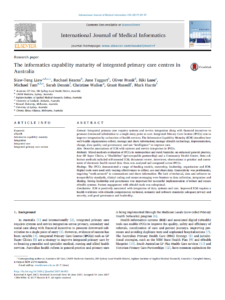 This paper on the informatics capability of primary care centres offering integrated models of care was just published online in the International Journal of Medical Informatics. (PDF)
This paper on the informatics capability of primary care centres offering integrated models of care was just published online in the International Journal of Medical Informatics. (PDF)
Liaw S-T, Kearns R, Taggart J, Frank O, Lane R, Tam CWM, et al. The informatics capability maturity of integrated primary care centres in Australia. International Journal of Medical Informatics. 2017;105:89-97.
Highlights
- Australian Integrated Primary Care Centres (IPCCs) vary in funding models, ownership, leadership, organisation and ICM.
- Digital tools were used with varying effectiveness.
- Connectivity was problematic, requiring “work-arounds” to communicate and share information
- Strong leadership and governance was important for successful implementation
- Patient engagement with eHealth tools was suboptimal.
- The ICM is positively associated with integration of data, systems and care.
Abstract
Context
Integrated primary care requires systems and service integration along with financial incentives to promote downward substitution to a single entry point to care. Integrated Primary Care Centres (IPCCs) aim to improve integration by co-location of health services. The Informatics Capability Maturity (ICM) describes how well health organisations collect, manage and share information; manage eHealth technology, implementation, change, data quality and governance; and use “intelligence” to improve care.
Aim
Describe associations of ICM with systems and service integration in IPCCs.
Methods
Mixed methods evaluation of IPCCs in metropolitan and rural Australia: an enhanced general practice, four GP Super Clinics, a “HealthOne” (private-public partnership) and a Community Health Centre. Data collection methods included self-assessed ICM, document review, interviews, observations in practice and assessment of electronic health record data. Data was analysed and compared across IPCCs.
Findings
The IPCCs demonstrated a range of funding models, ownership, leadership, organisation and ICM. Digital tools were used with varying effectiveness to collect, use and share data. Connectivity was problematic, requiring “work-arounds” to communicate and share information. The lack of technical, data and software interoperability standards, clinical coding and secure messaging were barriers to data collection, integration and sharing. Strong leadership and governance was important for successful implementation of robust and secure eHealth systems. Patient engagement with eHealth tools was suboptimal.
Conclusions
ICM is positively associated with integration of data, systems and care. Improved ICM requires a health workforce with eHealth competencies; technical, semantic and software standards; adequate privacy and security; and good governance and leadership.
